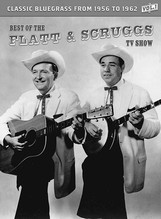
Before “Hullabaloo” or “Hootenany” there was the Grand Ole Opry, America’s first national country music show broadcast on the radio.
Of course the Opry garnered a slew of imitators, and when television came along, folks attempted to graft the format to this new media. One of these first attempts was “The Flatt and Scruggs Grand Ole Opry TV Show.” With only one advertiser – the Martha White Flour Company – Flatt and Scruggs had plenty of time to play music while pitching biscuits, cakes, and pies made with Martha White’s special “Hot Rize” ingredient. Almost 50 years later, these shows still deliver a boatload of tasty surprises.
Broadcast from 1955 until ’69, copies of the Flatt and Scruggs Grand Ole Opry shows had all but disappeared until 1989, when 24 episodes were found by advertising executive Bill Graham and donated to the Country Hall of Fame Museum. Twelve more episodes were later unearthed and also given to the museum.
Each of these two DVD volumes features two shows. Volume 1 has August, 1961, and February, 1962, while Volume 2 has July and August ’61. The museum has plans to issue two more volumes in late 2007.
Both discs have simple menus that give the option of playing the entire disc or choosing which program you want to watch. Each show has its own sub menu that allows the viewer to choose a particular song (or commercial) or watch the entire program from beginning to end. Neither disc has any additional features. All the shows have a similar format; an introduction by radio announcer T. Tommy Cutrer, several songs, a Martha White “demonstration” segment, more songs, another demonstration, then another song or two before the final credits. Each show has several “spotlight” segments. Earl Scruggs plays fingerpicked guitar for at least one song, dobro virtuoso Josh Graves gets one solo number, fiddler Paul Warren does a fiddle tune, the entire band performs a gospel vocal quartet, and bass player E.P. “Cousin Jake” Tullock and “Uncle” Josh Graves do their comedy section consisting of a bad old joke.
Picture quality on these discs is pretty decent. The original black and white shows were done on early 2″ videotape that was transferred to film for distribution. Although you’ll see an occasional glitch or stutter, by and large, the tapes survived in excellent shape. These film copies also have surprisingly good monophonic sound (although at times slightly out of synch with the picture) with only moderate roll-off on the top and bottom ends of the frequency spectrum. You can hear some tape hiss, but it never gets distracting. The studio had two cameras and most of the camera work and editing consists of cutting between the two. One camera supplies medium length shots while the other delivers nice close-ups of the players’ fingers. Although the resolution isn’t good enough to pick up actual notes and licks, you do get a reasonable view of Earl Scruggs’ and Josh Graves’ right-hand techniques.
Vintage-instrument aficionados will appreciate the opportunity to see Scruggs’ five-string Gibson banjo and Lester Flatt’s Martin dreadnought in action. Mandolin players will notice that Curley Seckler played a Gibson F-4 oval-hole mandolin instead of an f-hole F-5 like Bill Monroe. He also takes no mandolin solos. The most interesting instrument on the show is undoubtedly the guitar used by Scruggs for fingerpicking; this Martin dreadnought featured a pickguard that covered two-thirds of its face, shielding everything in front of the bridge in protective tortoiseshell plastic. But the oddest thing is the truss rod cover on the headstock. Martin guitars of this vintage didn’t have adjustable truss rods, so this guitar certainly didn’t need a cover on the headstock to protect a nonexistent adjustment screw! Gibson envy, perhaps?
Any bluegrass fan with more than a passing interest in vintage performances will want these DVDs. While not quite as satisfying as a trip in a time machine back to the WSM TV studios, these discs deliver a clear picture of Flatt and Scruggs during their most musically influential period.
This article originally appeared in VG‘s Jun. ’07 issue. All copyrights are by the author and Vintage Guitar magazine. Unauthorized replication or use is strictly prohibited.


